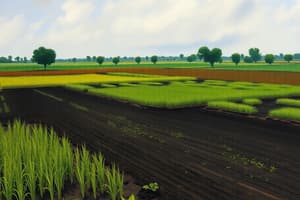Podcast
Questions and Answers
A farmer wants to cultivate a crop that requires minimal water. Based on the soil experiment, which type of soil would be most suitable?
A farmer wants to cultivate a crop that requires minimal water. Based on the soil experiment, which type of soil would be most suitable?
- Clay, as it retains the most water.
- A mix of clay and loam, providing a balance of drainage and retention.
- Sand, as it allows water to drain quickly. (correct)
- Loam, as it retains a moderate amount of water.
A farmer observes that their soil retains too much water, hindering plant growth. Which of the following would be the MOST effective strategy to improve the soil's suitability for agriculture?
A farmer observes that their soil retains too much water, hindering plant growth. Which of the following would be the MOST effective strategy to improve the soil's suitability for agriculture?
- Planting wheat, as it thrives in excessively moist conditions.
- Adding sand to the soil to increase its permeability. (correct)
- Cultivating maize, as it requires the most water.
- Introducing livestock grazing, as animals can tolerate waterlogged soil.
A farmer is deciding what to plant and knows the soil is fertile and retains a lot of water. Considering the relationship between soil type and agricultural suitability, which crop is MOST likely to thrive?
A farmer is deciding what to plant and knows the soil is fertile and retains a lot of water. Considering the relationship between soil type and agricultural suitability, which crop is MOST likely to thrive?
- Maize, because it needs little water.
- Sand, because it supports diverse root systems.
- A variety of root vegetables.
- Wheat, because it thrives in very fertile soil with lots of water. (correct)
A farmer wants to maximize the yield of wheat on their land. Which of the following soil characteristics would be MOST beneficial for this purpose?
A farmer wants to maximize the yield of wheat on their land. Which of the following soil characteristics would be MOST beneficial for this purpose?
A farmer is assessing a new plot of land and discovers that it is predominantly clay soil. Which of the following long-term strategies would be MOST sustainable for utilizing this land?
A farmer is assessing a new plot of land and discovers that it is predominantly clay soil. Which of the following long-term strategies would be MOST sustainable for utilizing this land?
Flashcards
Soil's Importance to Farmers
Soil's Importance to Farmers
Soil type dictates which plants can grow, impacting crop selection and yield.
Sandy Soil
Sandy Soil
Soil with high permeability, allowing water to drain quickly. Good for plants that don't need much water.
Loamy Soil
Loamy Soil
A fertile soil type that retains moisture well, ideal for plants needing lots of water.
Clay Soil
Clay Soil
Signup and view all the flashcards
Agriculture
Agriculture
Signup and view all the flashcards
Study Notes
- The type of soil is important for a farmer.
- It is important to understand the link between soil and agriculture.
Soil and Agriculture
- On sandy soil, a farmer can grow maize because it doesn't need much water.
- On loamy soil, a farmer can grow wheat because it needs lots of water; loamy soil is very fertile.
- On clay soil, a farmer can let animals graze because clay keeps too much water for plants.
- There is a link between soil and agriculture, soil has an influence on the plants that can grow.
- Farmers need to check the soil before they start planting.
- Agriculture needs soil, and people need agriculture because it provides food.
- Agriculture is the first use of rocks by people.
Studying That Suits You
Use AI to generate personalized quizzes and flashcards to suit your learning preferences.




